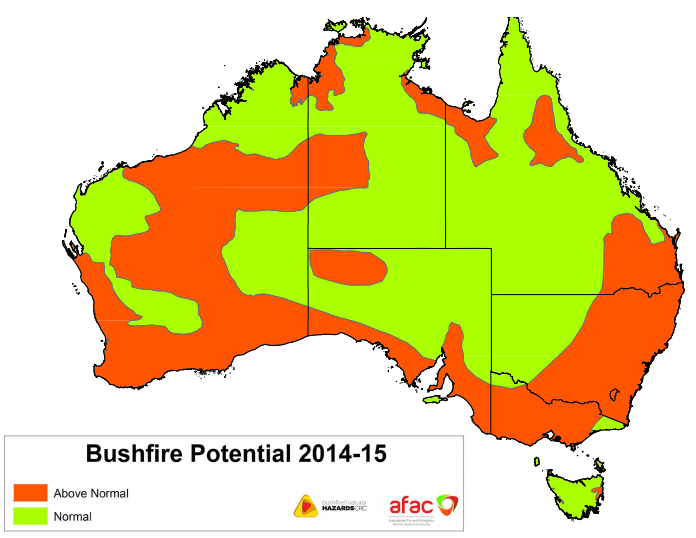The official bushfire outlook for Southern Australia has been revised to include upgraded warnings for several areas following an unseasonably dry spring.
The significant change to the new outlook compared to the previous outlook issued in September is that more parts of south eastern Australia are now expected to experience above normal fire conditions.
The Bushfire and Natural Hazards CRC says that in these areas, it is more likely that the resources required to fight bushfires from within a region will be insufficient, with resources required from other areas of an affected state, interstate and possibly overseas.
Record October warmth across much of southern Australia has caused a rapid drawing of moisture from the landscape which is raising expectations of high fire danger in the south eastern states.
This has increased the bushfire potential in Victoria, South Australia and Tasmania sufficiently to warrant the updating of the national perspective, the CRC says.
The above map reveals the updated bushfire outlook for southern Australia through to 2015.
This map has been combined with the outlook for the northern fire season from July 2014, to show the areas of fire potential for all of Australia in 2014-15.
REGIONAL SUMMARIES:
Victoria
The expectation of an above normal fire season for 2014-15 has extended in Victoria. The outlook has changed to a potentially major fire season.
All Victorian districts except the Mallee and East Gippsland may expect above normal fire potential. The continuation of dry conditions in all districts except East Gippsland, coupled with an increased likelihood of an earlier start to the season, has extended the above normal outlook beyond the geographic extent advised in September.
Longer term rainfall deficits have emerged across much of the state, including key areas along the Great Dividing Range. Critical shorter term deficits in coastal and southern Victoria coincide with areas of tall forest with
no recent history of fire. Critical deficits also coincide with vulnerable areas in the Great Dividing Range where forests have been killed by fire in the past 10 years.
New additions include Wyperfeld, the Far South West, the Otway Range, the eastern Melbourne region, forests in the Great Dividing Range as far east as the Tongio Plateau and the Cobberas Range, Melbourne’s water catchments, the foothills of South Gippsland, Wilsons Promontory and the Latrobe Valley.
Climatic signals indicate the continuation of warmer and drier than average conditions. Significant or widespread above average rainfall is not forecast. Rainfall of 30-50mm may occur in places, but its effectiveness will
be limited due to the antecedent conditions.
South Australia
In South Australia the outlook conditions indicate the most likely scenario is for above normal fire potential in many parts of the state.
In the North West Pastoral, West Coast, Eastern Eyre Peninsula, Flinders and Mid North districts, the above normal fire potential is due to accumulated growth from previous growing seasons and above average rainfall earlier in 2014.
The Yorke Peninsula, Mount Lofty Ranges, Upper South East and Lower South East districts are experiencing rainfall deficiencies, with very dry soil moisture resulting in very dry fuels.
The area adjacent to the Northern Territory border (north of the APY Lands) has normal fire potential, in line with the normal potential indicated by the Northern Territory.
Normal to above normal fire potential may see the need for firefighting resources over a longer period of time, together with a longer time for mop up post-fires. The districts where there is potential for above
normal activity may pose resourcing issues during this fire danger season, should an above normal level of activity be experienced.
Tasmania
The extraordinary run of above average maximum and minimum temperatures continues, while dry conditions in September and October were only relieved by significant rain in the last week of October.
Difficult fires have already occurred; on 28 September Tasmania experienced the earliest total fire ban since 1987.
The central part of the east coast extending into Fingal continues to have above normal fire season potential.
Without an improvement in conditions, the area from St Helens down to Marion Bay and through the Midlands and lower Derwent Valley are all likely to have above normal potential at the beginning of summer.
Other states and territories In New South Wales, the ACT and Western Australia, the Southern Australia Season Bushfire Outlook remains as described in September’s outlook.
To read the full revised outlook click here




HAVE YOUR SAY